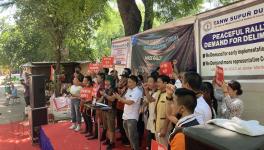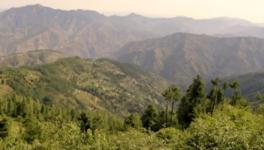Arunachal: Indigenous Peoples’ Struggle Against Siang Mega Dam

Tribals in Siang river belt in Arunachal Pradesh demonstrating against a proposed mega hydropower dam. Photo Credit: The Hindu
The proposed Siang mega-dam in Arunachal Pradesh, a bordering state to China located in the north-eastern region of India, has been a subject of organised protest and resistance from the indigenous communities residing in the region. These communities, primarily from the Adi and other tribes, have long-standing ties to the Siang River on which the construction of dam is proposed. The river and its surrounding ecosystems are integral to livelihoods, culture, and identity of indigenous communities. Though the proposed project is primarily aimed at enhancing India’s geopolitical security and generating hydroelectric power to meet the growing demand for green energy, it has raised serious concerns among these communities, who clearly perceive it as a direct threat to their livelihoods, environment and overall way of life.
The resistance against the Siang mega-dam is not merely a reaction to a modern development project but is rooted in deep historical, social, environmental, and cultural factors. Historically, the indigenous people of Arunachal Pradesh have experienced marginalisation and external imposition, which has fuelled a strong sense of local autonomy and a desire to protect their land and natural resources from exploitation. Socially, these communities view the dam as a potential disruption to their traditional governance systems and community-based ways of life. Environmentally, the Siang River holds immense ecological significance, and its alteration could jeopardize the fragile balance of the region’s biodiversity. Culturally, the river and its landscape are woven into the myths, rituals, and practices of these indigenous groups, making the threat of its submergence feel like an existential challenge.
The protest against the Siang Upper Multipurpose Project has been ongoing since the inception of the Siang Dam proposal. However, the issue has resurfaced again in the political and social discourse of Arunachal Pradesh, as the state government, led by the Bharatiya Janata Party (BJP), remains determined to conduct the pre-feasibility report (PFR) for the proposed 12,500 MW project. The state government is pursuing a controversial course of action in the face of strong opposition from indigenous groups, even going so far as to deploy armed forces and militarise the region. This aggressive stance raises important questions about the government’s motives and the underlying reasons for the resistance. A closer examination of these issues is essential to understand the broader dynamics at play, including the protection of indigenous land rights, environmental concerns, and the preservation of cultural heritage. Therefore, this essay seeks to explore the various layers of opposition to the Siang Upper Multipurpose Project, focusing on the indigenous perspective. By examining historical context in which the project was proposed, social dynamics, environmental risks, and cultural values, the report will offer a comprehensive understanding of the resistance and the broader implications of such large-scale development projects on indigenous communities.
Background of the Siang Dam project
In 2009 the Union Government –then UPA II led by the Indian National Congress–had approved the construction of Mega Dam under the ‘Siang Upper Multipurpose Project’ on the Siang River, a tributary to Brahmaputra River in Arunachal Pradesh to act as a safeguard in case China diverts the river’s waters from Tibet to its dry north-western regions.[1] The main objective of the proposed ‘Siang Upper Multipurpose Project,’ is to counter China’s strategic plan to divert the natural flow of the Yarlung Tsangpo River, which flows as the Siang in Arunachal Pradesh and as the Brahmaputra in Assam.[2] This project has been promoted as a way to secure India’s water interests, especially in the face of growing concerns over China’s plans to build large-scale dams along the Yarlung Tsangpo, which could significantly alter the river’s flow into India. The diversion of the river by China could potentially impact the water supply and ecological balance within India, particularly in the north-eastern states. In addition to addressing the geopolitical concerns related to China’s aggressions and actions, the Siang Upper Multipurpose Project also aims to address local “challenges” such as flood management on the Brahmaputra River. The Brahmaputra is prone to severe flooding, particularly during the monsoon season, which causes significant damage to infrastructure, agriculture, and livelihoods. The project is being positioned as a solution to regulate water flow, manage floods more effectively, and mitigate the damage caused by seasonal floods.
However, the local communities have been raising concerns about the Siang Project for over a decade, since its inception. A major concern raised by the Siang Indigenous Farmers Forum (SIFF) president Gegong Jijong is that the proposed dam poses a significant threat to the very existence of the indigenous community.[3] He strongly emphasised that the construction of the dam would result in the submergence of two districts, effectively erasing not only the physical landscape but also the cultural and historical fabric of the Adi community who are majority in the region. Jijong’s statement underscores the community’s apprehension about the project, as they fear it will lead to the loss of their ancestral land, which is central to their identity, as well as their heritage and traditions. For the Adi people, the land is not just a place of residence; it is intricately tied to their cultural practices, rituals, and way of life. The threat of displacement is not merely about losing homes but also about the erasure of a way of life that has been passed down through generations. The SIFF said that the proposed dam, if constructed, will lead to large-scale devastation in the Siang valley and any quantum of compensation will not suffice to rehabilitate the people. It further says that, “There is also lurking-danger of wiping out the rich cultural heritage and history of the people in such eventuality.”[4] The dam, according to Jijong and many in the community, would destroy the intimate connection between the people and their land, culture, and history, leaving them vulnerable to cultural extinction.
Apart from this, the manner in which the state is handling the Siang Project has left many people feeling confused and frustrated. Despite the serious concerns raised by local communities, the state’s actions seem to lack transparency and adequate engagement with those directly impacted. The World Commission on Dams has long recognised that large dam projects can lead to the impoverishment and suffering of millions, which has led to the establishment of strict standards and guidelines for future mega-dam projects. One of the key principles emphasised by the Commission is that projects should be guided by the affected people, ensuring their rights and concerns are prioritized. It is also mandatory under these guidelines that free, prior, and informed consent be obtained from the communities and families that would be affected by the dam.[5]
However, in the case of the Siang dams, the SIFF has raised the alarm that no such consultation or consent was sought from the local population before the signing of the Memorandum of Agreement (MoA) with the power developers. This lack of transparency and engagement with stakeholders has only deepened the sense of injustice and alienation among the people, as they feel excluded from critical decisions that directly affect their lives and futures. In response to these concerns, the SIFF has taken a proactive role in opposing the project, organising protests and leading resistance efforts to ensure that the rights of the indigenous communities are not overlooked. Their efforts gained legal footing when, in 2014 when SIFF filed a public interest litigation in the Itanagar permanent bench of the Gauhati High Court.[6]
The petition raised alarm over the environmental, social, and cultural impacts of the dam, particularly the displacement of local communities and the loss of ancestral lands. The court’s ruling was a significant step in recognising the importance of community consultation. The court directed the state government to engage with the affected communities before taking any further action on the project. This ruling underscored the need for transparency and the inclusion of local voices in decisions that would have far-reaching consequences. Despite this, the community remains sceptical of the government’s commitment to addressing their concerns, especially as surveys and preparations for the project have continued without meaningful consultation or consent.[7] In December 2022, residents were taken aback when they discovered that surveys for the project were being conducted in the early hours of the morning, without prior consultation or notice. This unexpected and stealthy activity further fuelled the community’s opposition and raised doubts about the project’s transparency.
This massive hydroelectric project, aimed at harnessing the Siang River’s potential, has ignited significant opposition from indigenous communities in the Siang and Upper Siang districts. These communities, who have a deep cultural, social, and environmental connection to the river, have strongly protested the government’s plans. In response, the state has deployed security forces to carry out the PFR, viewing the project as a development opportunity that will bring economic growth, energy, and infrastructure to the region along with protecting national security of India.[8] However, the militarization of the area and the forceful execution of the PFR have raised critical questions about the state’s approach to the implementation of the project, the disregard for judicial orders to include local concerns, and the imposition of external decision-making processes.
Indigenous peoples’ perspective on displacement, land, loss of livelihoods and erasure of culture caused by dam projects in the Siang Valley
Arunachal Pradesh, stands out for its rich forest resources. The State of Forest Report of 2003 ranks Arunachal Pradesh second in the country after Mizoram for forest cover, with 68,019 square kilometres under forested areas that are rich in bio-resources and forest cover. It is the home for several tribal communities, including the Adi tribe. The Adi tribe primarily resides in the East, West, and Upper Siang districts.[9] Historically, large dam projects have disproportionately affected marginalised communities, often displacing them without providing significant benefits. The World Commission on Dams has rightly highlighted that tribal people are frequently the most vulnerable to the negative consequences of these projects, suffering displacement and loss of vital resources.[10]
This has been the case for many large dam projects, where marginalised communities, particularly tribal populations, have suffered significantly. In the case of the Sardar Sarovar Dam in the Narmada river valley, Major General Sudhir Vombatkere (retired) has written to Prime Minister Narendra Modi and brought his attention to the displacement of Dalit and Adivasi families because of this dam, who are yet to be rehabilitated. There are more than 250,000 project-affected people, he writes, have been subject to “serious injustices and violation of fundamental rights.”[11] The Narmada Valley Development Project, which has been a subject of controversy for decades, is originally conceived in 1946 and commenced in 1978. However, despite the long history of the project, the affected communities continue to face unaddressed displacement issues even in 2024. In the case of proposed ‘Siang Upper Multipurpose Project’ in Arunachal Pradesh, is going to affect specifically the Adi community living along the Siang River. Given the troublesome history of injustice mated out with displaced communities due to mega dam projects, the Adi community have reasons for their strong opposition to the proposed mega dam due to the profound impact they would have on their land, livelihood, and culture.
Adivasi (tribal) communities, often perceived as being reliant on the natural resources for their survival. Their lifestyles are deeply intertwined with the land, forests, and other natural elements, making the relationship between man and nature crucial for their livelihood. Therefore, the primary concern of the Adi community is displacement. The proposed dam project will flood large areas of both Siang and Upper Siang districts, submerging 13 villages and severely affecting 34 others. For a community that relies heavily on agriculture, this represents an existential threat to their way of life. Gegong Jijong, president of the Siang Indigenous Farmers’ Forum (SIFF), stated that the displacement would render over 100,000 members of the Adi tribe landless, threatening their survival and forcing them into poverty.[12] The name Adi means hill man,[13]therefore, as Jijong and other leaders have pointed out, the issue of displacement for Adi is not just the loss of land, but the loss of their connection to ancestral homes, agricultural practices, and cultural traditions.
Indigenous people in the region primarily depend on paddy cultivation and orange orchards for their sustenance. Losing this land would mean losing their ability to support themselves, undermining their self-sufficiency and disrupting their entire way of life. For the Adi people, agriculture is not just a means of survival, but an integral part of their identity and heritage. Vijay Taram, an anti-dam activist with the Forum for Siang Dialogue, shares these concerns, emphasizing the potential devastation of large-scale dams. While small dams or those built on tributaries might be acceptable, Taram warns that mega-dams could flood fertile agricultural lands and destroy the local ecosystem, jeopardizing food security and biodiversity.[14] Moreover, the construction of large dams would displace thousands of people from their ancestral lands, further undermining their cultural ties.
Bio-resources are not just physical commodities; they also play significant roles in social and cultural contexts. Therefore, Siang River is far more than just a water source for the people of Arunachal Pradesh. It is deeply intertwined with the cultural and spiritual identity of the indigenous communities, especially the Adi people. The river is considered the lifeline of the Siang valley, serving not only as a physical resource but also as a vital part of the region’s mythology, folklore, and cultural heritage. As mentioned in a statement by the SIFF, the Siang River has been “etched strongly in the psyche of the people” for centuries. Its name appears in cultural expressions such as songs, history, and myths.
Taram also highlights the fact that for the indigenous communities in the Siang Valley, the loss of traditional hunting grounds, vital for their sustenance and culture, would sever a deep connection to their environment. In spring, the Adi people celebrate the Aran festival, a time when the village men venture deep into the forest for several days to hunt game. During this sacred ritual, they appease the spirits with offerings of apong,[15] the traditional millet beer, and prayers.[16] However, such cultural practices are increasingly threatened by displacement, as large-scale projects like dams encroach upon their ancestral lands, disrupting not only their way of life but also their deep spiritual connection to the land they have long inhabited. The displacement would thus not only disrupt their livelihoods but would also erase cultural practices that are deeply intertwined with their land. Therefore, the opposition to the dam projects is not merely an environmental concern but a fight to preserve the cultural and economic integrity of the tribal communities of the Siang Valley.
The cultural destruction tied to the loss of ancestral land is immeasurable, as it erases generations of lived experiences, stories, and traditions. This emotional and cultural toll is one of the concerns of the indigenous people, who see the river as an essential part of their identity. Though Adi is predominant tribe in the region, there are numerous other indigenous communities in small number there. As several villages including Gelling, Tuting, Yingkiong and Geku would also get submerged once the dam was constructed. There is lurking danger of several of small tribal communities getting wiped out from the face of the earth. “Once uprooted, our culture, or language, our heritage will be all lost simply because some people elsewhere require electricity. Can this be justified,” Tasik Pangkam, general secretary of the SIFF asked at a press conference at Guwahati.[17]
Environmental Aspects of opposition:
Beyond the displacement, environmental concerns are also a major factor in the opposition to the dam. As the concerns are also about the environmental damage and the irreversible loss of their cultural heritage. These communities have long depended on the land, forests, and rivers for their survival, and the proposed dam threatens to disrupt this delicate balance. The construction of such a large-scale project on the Siang River threatens the fragile ecosystem of the region, which is already under strain. The Himalayan region, where the Siang River flows, is seismically very active. Studies indicate that enough geological pressure has accumulated in the region to cause earthquakes with magnitudes of 8 or greater. This adds another layer of fear, as the construction of a mega dam in such a volatile area could aggravate the risks of a natural disaster, potentially triggering catastrophic consequences in the event of an earthquake.
One of the critical concerns raised by the indigenous communities, particularly in relation to the proposed dam project on the Siang River, is the threat of a Glacial Lake Outburst Flood (GLOF). Such events, where water from glacial lakes bursts out, causing devastating floods downstream, pose a significant risk in the region. A recent example of this occurred in the Teesta River of Sikkim in 2023, where a GLOF caused widespread destruction. According to experts and local leaders, there are several glacial lakes located across the three districts of Siang, Upper Siang, and East Siang that are flagged as being of “Category A,” indicating they are at the highest risk of a GLOF. These lakes are situated in the Himalayan region, which is known for its seismic activity and shifting glacial patterns. The construction of large dams in such a sensitive region could exacerbate the risks associated with these glacial lakes, potentially triggering catastrophic flooding in the event of a GLOF. For the local communities, this adds another layer of fear to the already existing concerns about displacement, and cultural loss. The possibility of a GLOF, especially in a region where communities are heavily dependent on the land and river systems, only deepens their opposition to the project, as they fear the unforeseen and catastrophic consequences such natural disasters could bring.
Siang Valley also presents a world of unparalleled diversity, much of it yet to be explored. However, this very richness, both cultural and ecological, faces unprecedented threats. Large-scale infrastructure projects like dams, highways, and military installations, along with climate change, are rapidly altering the valley. The impact extends beyond the valley itself, as these mountains play a critical role not only in sustaining their diverse ecosystems but also in ensuring the well-being of millions of people living downstream.[18]
Protests and advocacy: role of SIFF and other community groups in leading the resistance
In the face of the proposed Siang Upper Multipurpose Project and other mega-dam initiatives in the Siang Valley, a number of local community groups and student organisations have emerged as vocal advocates against the displacement and environmental degradation these projects threaten to cause. Central to the resistance are groups like the Siang Indigenous Farmer’s Forum (SIFF), the All Upper Siang District Students’ Union (AUSDSU), the Siang People’s Forum (SPF), and the Lower Siang Dam Affected Peoples’ Forum (LSDAPF), who have been at the forefront of the anti-mega dam movement. These organisations have played a pivotal role in mobilising local communities, voicing concerns about the environmental, cultural, and socio-economic impacts of the proposed dam.
The Siang Indigenous Farmer’s Forum (SIFF) has been one of the key groups leading the charge against the Upper Siang Multipurpose Dam. As an organization representing indigenous farmers, SIFF has brought attention to the potential risks to agriculture, food security, and local livelihoods posed by the dam’s construction. By organising rallies, awareness campaigns, and advocacy efforts, SIFF has been instrumental in raising public awareness about the issue. They have also highlighted the potential for severe ecological disruptions, including the loss of biodiversity and the alteration of local river systems that communities depend on for their way of life.
Other groups, such as the All Upper Siang District Students’ Union (AUSDSU), have played a crucial role in mobilising the youth and students in the region, tapping into their energy and commitment to preserving the environment and their culture. These students have participated in protests, petitioned government officials, and engaged in dialogue with policymakers to push for the cancellation of the project. The Siang People’s Forum (SPF) and Lower Siang Dam Affected Peoples’ Forum (LSDAPF) have similarly been at the helm of organizing protests and lobbying for the protection of local communities’ rights. These forums represent a broader coalition of indigenous groups, farmers, and local residents who fear the social and environmental costs of the proposed projects. Their activism has been a powerful force in drawing national attention to the issue, with their appeals reaching both the United Progressive Alliance (UPA) and the current National Democratic Alliance (NDA) government.
How communities have ensured their voices are heard
The resistance against the Siang Upper Multipurpose Dam has been marked by a variety of strategies and actions aimed at making the voices of local communities heard. One of the most prominent actions taken has been the organisation of peaceful rallies and protests. These public demonstrations are a key tool for rallying support, showing solidarity, and creating awareness about the potential impacts of the dam. For example, Dubit Siram, an activist involved in the movement, announced plans for a peaceful rally with two primary demands: the withdrawal of Central Armed Police Forces (CAPF) deployment in the region and the complete cancellation of the proposed Project Feasibility Report (PFR) for the Siang Upper Multipurpose Project. This protest, set to take place in Parong, highlights the communities’ ongoing efforts to resist both the physical presence of state security forces and the government’s support for the dam project.[19]
Beyond rallies, the community groups have also petitioned both the state and central governments, urging them to halt the dam construction and recognize the importance of protecting the indigenous people’s land and culture. They have appealed to political leaders at both the state and national levels, including the chairperson of the United Progressive Alliance (UPA), Sonia Gandhi, and now the leadership of the National Democratic Alliance (NDA) and Bharatiya Janata Party (BJP), seeking support for their cause. These petitions and appeals often include testimonies from affected communities, emphasising their concerns about displacement, cultural erosion, and environmental destruction.[20]
A comparative analysis of agitations against land and resource exploitation in India
India, a country rich in natural resources, has been the site of numerous movements where local communities, especially marginalized groups, have resisted large-scale industrial, infrastructural, and mining projects that threaten their land, livelihoods, and cultural identities. These agitations highlight the ongoing conflict between economic development and environmental protection, emphasizing the need for more inclusive and sustainable policies.
One of the most prominent and long-standing agitations in India is the Narmada Bachao Andolan (NBA), launched in the late 1980s in opposition to the construction of large dams on the Narmada River. The central concern of this people’s movement has been the displacement of thousands of tribal and rural communities, particularly in Madhya Pradesh, Maharashtra, and Gujarat. The NBA argues that the dams, including the Sardar Sarovar Dam, will submerge vast areas of land, displacing indigenous populations without providing adequate rehabilitation or compensation. Furthermore, the project threatens the ecological balance of the river and the surrounding area. The struggle of the NBA exemplifies the tension between large-scale development projects and the rights of marginalized communities, with the movement highlighting the failure of the state to address the socio-economic and environmental consequences of such mega projects.
Another such controversial mega project in North Eastern region of India is the Tipaimukh multipurpose Hydro-Electric Project (HEP), proposed to be constructed on the Barak River in the state of Manipur. The Tipaimukh project is a proposed multipurpose hydroelectric project on the Barak River in the state of Manipur, and is one of the largest infrastructure projects planned for Northeast India. Originally conceived in 1926 to control the annual devastating floods in the Barak Valley (Assam, India), the project later incorporated hydropower generation into its design. The formal proposal for the dam was prepared in 1984, and the project was officially notified in 2003. Environmental clearance for the project was granted by the Ministry of Environment and Forests in 2008, despite significant concerns regarding its potential impact on the region’s ecology and local communities.[21]
This project also has sparked widespread protests from locals, academics, researchers, social activists, NGOs, and even neighbouring Bangladesh. The ongoing debate highlights that the Tipaimukh project is one of the most poorly planned initiatives in the region, with far-reaching environmental, geopolitical, and socio-economic consequences. The project poses significant threats to the livelihoods, food security, culture, identity, and rights of the indigenous people living in the area. In addition, its environmental repercussions are alarming, threatening biodiversity, hydrology, water quality, and forests both upstream and at the dam site. The potential impacts on downstream communities are equally profound, further exacerbating the risks for the environment and the people who depend on it.
In Hasdeo Arand, Chhattisgarh, Adivasi communities have been at the forefront of protests against coal mining activities in one of the last remaining large forests of central India. The proposed coal mines threaten the forest’s rich biodiversity, the water sources, and the livelihoods of Adivasi communities who rely on the forest for sustenance. The anti-coal mining movements in Hasdeo Arand reflect the broader struggle of indigenous populations across India who seek to protect their land and resources from exploitation. These movements emphasize the urgent need for policies that recognize the rights of indigenous communities to their ancestral lands and the importance of protecting forests for future generations.
Over the years, protests against mining in the Hasdeo forest, particularly at the Parsa East Kente Basan (PEKB) mine, have become a focal point for environmentalists fighting to protect forest lands from being converted into mines. In 2022, permission for the second phase of mining at the PEKB site was granted by the pro-corporate, ultra-right Bharatiya Janata Party (BJP)-led central government. However, this decision sparked widespread protests, leading the Congress-led state government to oppose the move. In response, the state government filed an affidavit in the Supreme Court, arguing that the land used by the previous phase of the PEKB mine still contained enough coal approximately 350 million tonnes to sustain the attached 4,300 MW power plant for the next 20 years, rendering the second phase unnecessary. Despite this opposition, the BJP government, both at the state level (under the newly elected BJP leadership) and at the national level, granted additional permissions to the Adani-controlled company to continue mining. The justification for this decision was that the first phase of the mine had been exhausted, prompting the need for further mining to meet energy demands.
The various agitations against land and resource exploitation in India share common themes of resistance against large-scale industrialisation and infrastructure projects without consent and consultation with stakeholders that disproportionately impact marginalized communities. Whether it is the Narmada Bachao Andolan or the protests against coal mining in Hasdeo Arand, these movements reflect a broader struggle for environmental justice, indigenous rights, and the protection of local livelihoods. Each movement highlights the conflict between development and sustainability, and underscores the need for more inclusive policies that respect the rights of local communities and safeguard the environment. As India continues to pursue economic growth, it must balance development with a commitment to social justice, environmental protection, and the preservation of cultural identities. The future of such projects depends not just on their economic feasibility, but on their ability to integrate the voices and concerns of those who stand to be most affected.
State’s Approach to Siang Dam Project and Its Implications
The state’s approach to the project has evolved over time, particularly in light of the growing opposition from local groups, environmental activists, and even concerns voiced by hydropower companies. This response underscores the tension between the state’s pursuit of large-scale development and the needs, rights, and concerns of the local population. In the current scenario, the State’s approach to securing the project has also been contentious. To tackle the opposition state has provided round-the-clock security for the project sites. The Central Armed Police Forces (CAPF) are being strategically deployed to the region, with plans to station five companies of CAPF in Siang, including one in East Siang.[22] The deployment will cover critical locations such as NHPC offices and camps in areas like Boleng and Pasighat, which are pivotal for the dam’s construction. Along with these forces, State Police and Lady Police contingents are being mobilized to ensure comprehensive security arrangements for the project. This militarized response has heightened tensions in the area, as local groups like the Siang Indigenous Farmer’s Forum (SIFF) and other activists accuse the government of harassing protestors. The presence of security forces is seen as an attempt to suppress opposition and prevent peaceful protests against the dam, further alienating the affected communities.
Local communities have consistently voiced strong opposition to large dam projects, raising concerns about their environmental, social, and economic impacts. Despite these objections, the authorities have often overlooked community demands. The State has altered the initially proposed dam project which was intended to be developed in two stages. The current proposal combines both stages into a single larger project.[23] This shift has raised concerns not only among environmentalists and activists but also within the hydropower sector. Siang Indigenous Farmers’ Forum (SIFF) has opposed the merge of Stage I and Stage II of the power project over the Siang River. The state government had signed a memorandum of agreement with the public-sector company in May 2013. They had started initial survey work for the original Stage-2 project, but now it has put it on hold as per the government’s instructions. Sania Ngurang, the Arunachal Pradesh coordinator for North Eastern Electric Power Corporation (NEEPCO), has expressed scepticism, stating that merging the two stages into one large project may not be the best approach.[24] However, the NITI Aayog stated that the merging of two projects into one Mega project will not only exceed their combined capacity but will reduce the project cost by 25%.[25]
The amendment to the Forest (Conservation) Act, 1980, introduced in 2022, which has made it easier for governments and developers to acquire land for business purposes. These changes have sparked concerns that local stakeholders, especially forest-dwelling communities, are being side-lined in the decision-making process. Forest rights activists and advocates argue that the new rules undermine the protections offered by the Scheduled Tribes and Other Traditional Forest Dwellers (Recognition of Forest Rights) Act, 2006 (FRA). The FRA was designed to give forest-dwelling communities the right to decide how to manage and use the land on which they live, recognizing their deep connection to the forest and its resources. Critics of the changes contend that the new rules will dilute these rights, potentially displacing communities without adequate consultation or compensation, and jeopardizing their livelihoods and traditional ways of life.
One of the major legal developments that has raised alarm among activists and local residents is the Forest (Conservation) Amendment Act of 2023, which allows the Indian government to divert forests for strategic projects within 100 kilometres of the international borders without the need for forest clearance. This new provision directly affects the Siang Dam project, as the region lies near India’s international borders with China and Bhutan.[26] Bhanu Tatak, a prominent anti-dam activist, has pointed out that this law could bypass crucial environmental safeguards that normally govern forest conservation. He states, “The Siang dam is being pursued as a national strategic project, and according to the new forest law, there will be no need for forest clearance.”[27] This move raises significant concerns about the environmental impact of the project, particularly on the biodiversity and ecosystem of the Siang Valley, an area rich in forests, wildlife, and river systems that are critical to the local community’s way of life.
The Upper Siang hydropower project will be built by the National Hydroelectric Power Corporation (NHPC). The NHPC has identified three potential sites along the Siang River- Uggeng, Ditte Dimme, and Parong to assess the feasibility of constructing the Siang Dam. A pre-feasibility report, which serves as a concept paper ahead of a detailed project report, is being prepared to evaluate the probable cost and viability of the dam at these sites. As part of the survey, NHPC is conducting geological tests, including drilling a 200-meter-deep hole to assess the strength of the rock surface in the proposed locations. The pre-feasibility reports from the three sites will be compared to determine the most suitable location for the dam. Based on the findings, NHPC will finalise the dam’s location. However, despite the progress in these initial assessments, the construction of the dam is not expected to begin for at least another five years. This delay is primarily due to local resistance and opposition to the project, which is a significant hurdle. Furthermore, the preparation of a detailed project report will run parallel with the process of obtaining environmental and forest clearances, which are crucial for moving forward with the project. The outcome will depend on navigating both technical and social challenges, including local opposition, environmental concerns, and securing the necessary legal approvals.
However, if completed, the proposed project aims to have an installed capacity of 11,000 MW, with a reservoir holding 9 billion cubic meters (BCM) of water. The estimated cost of the project is approximately Rs. 1,13,000 crores (US$ 13 billion).[28] This investment is expected to have a substantial economic impact on the Upper Siang district in Arunachal Pradesh, potentially acting as a catalyst for the region’s development. In its “defence”, the large-scale infrastructure development associated with the Siang Dam project would likely lead to significant improvements in the region’s infrastructure, including the construction of new roads and transportation networks, such as the approach road from Assam. These improvements could enhance connectivity, create job opportunities, and stimulate local economies.
However, the potential outcomes of the project are fraught with both benefits and challenges. On one hand, the project could contribute to a version and definition of “economic growth” of Arunachal Pradesh, boosting its energy capacity and providing a stable source of electricity for the region. This would not however be growth that empowers and enriches its indigenous communities, On the other hand, there are serious concerns about both environmental and social consequences. These include the displacement of indigenous communities, disruption of local ecosystems, and potential long-term ecological damage due to the alteration of river systems and landscapes. The ongoing opposition from local communities and environmental groups, who emphasise the need to protect indigenous rights and ensure sustainable development, presents a major challenge to the project’s implementation. The resolution of these concerns will depend on balancing top down version of development that does not necessarily factor in fragile economic systems especially in the hills with the protection of land rights, ecological and social values, particularly ensuring that local communities are genuinely included in decision-making processes. The final outcome will hinge on whether the project can be implemented in a way that addresses these environmental and social concerns while fostering long-term sustainable development.
Conclusion:
In conclusion, the proposed Siang mega-dam project stands as a contentious issue, embodying the intersection of development ambitions, geopolitical concerns, and the rights of indigenous communities. While the government positions the dam as a solution to both national security and local flood management challenges, it is clear that the indigenous people of Arunachal Pradesh, particularly the Adi community, view it as a profound threat to their land, culture, and way of life. The opposition to the Siang Upper Multipurpose Project from the indigenous communities, particularly the Adi tribe, is deeply rooted in concerns over displacement, loss of livelihoods, and the erasure of their cultural heritage. The proposed dam threatens not only the physical landscape but also the very essence of their identity and way of life. For the Adi and other tribal communities in the Siang Valley, the land is not just a source of sustenance; it is intricately tied to their spiritual beliefs, cultural practices, and collective history. The historical experiences of marginalised communities displaced by large dam projects, such as the Sardar Sarovar Dam, have left deep scars and fuelled the fears of similar injustices in Arunachal Pradesh. The loss of agricultural land, vital hunting grounds, and the destruction of sacred sites would result in cultural extinction for these communities, as their traditions and ways of life are intrinsically linked to their environment. Therefore, the resistance against the project is deeply rooted in historical experiences of marginalization, environmental concerns, and cultural preservation. The failure of the state to adequately consult and engage with local communities has fuelled resentment and a sense of injustice, exacerbating the conflict.
The efforts of organisations such as the Siang Indigenous Farmer’s Forum (SIFF), the All Upper Siang District Students’ Union (AUSDSU), the Siang People’s Forum (SPF), and the Lower Siang Dam Affected Peoples’ Forum (LSDAPF) have been crucial in mobilising communities, raising awareness, and advocating for the protection of their land, culture, and environment. These groups have effectively utilised peaceful protests, public rallies, petitions, and dialogue with policymakers to highlight the social, cultural, and ecological risks associated with the proposed dam. Ultimately, the resistance against the Siang mega-dam reflects the broader struggle for indigenous rights, environmental justice, and cultural preservation. The movement is not only about halting a dam project but about asserting the right of indigenous communities to determine their own future and protect their way of life from destructive development. The ongoing efforts of these advocacy groups emphasize the need for genuine dialogue, transparency, and respect for the rights of local communities in shaping development projects that impact their lands and livelihoods. Only through such an inclusive approach can a balanced and sustainable path forward be found, one that respects both the development goals of the state and the cultural integrity of indigenous communities.
Despite legal rulings that emphasise the need for community consultation and consent, the government’s ongoing actions, including militarizing the region and conducting surveys without notice, suggest a disregard for the principles of transparency and inclusivity. As the opposition to the Siang dam continues to grow, it highlights the broader implications of large-scale development projects in indigenous territories. It underscores the necessity for a more equitable and participatory approach to development that respects the rights, voices, and sovereignty of indigenous peoples. Moving forward, the government must carefully balance the need for national development with the protection of indigenous rights and cultural heritage, fostering dialogue and collaboration that prioritizes the well-being of local communities. Without this, the Siang mega-dam may not only disrupt the physical landscape but also irreparably damage the social and cultural fabric of Arunachal Pradesh’s indigenous peoples.
[1]https://web.archive.org/web/20110526054814/http://www.telegraphindia.com/1090402/jsp/northeast/story_10760784.jsp
[2] https://www.natstrat.org/articledetail/publications/upper-siang-hydroelectric-project-key-to-prosperity-in-arunachal-pradesh-99.html
[3] https://arunachal24.in/arunachal-no-dam-no-survey-on-siang-river-says-farmers-forum/
[4] https://arunachaltimes.in/index.php/2023/03/30/forum-raises-mega-dam-issues-submits-memo-to-un-south-asia-business-and-human-rights-forum/
[5] https://arunachaltimes.in/index.php/2023/03/30/forum-raises-mega-dam-issues-submits-memo-to-un-south-asia-business-and-human-rights-forum/
[6] https://arunachaltimes.in/index.php/2023/03/30/forum-raises-mega-dam-issues-submits-memo-to-un-south-asia-business-and-human-rights-forum/
[7] https://thewire.in/environment/siang-arunachal-pradesh-upper-multipurpose-project-protests
[8] https://www.etvbharat.com/en/!bharat/arunachal-pradesh-communities-up-ante-against-the-siang-mega-hydro-power-project-enn24121405501
[9] https://www.researchgate.net/profile/Gibji-Nimasow/publication/228872543_Linkages_between_Bio-Resources_and_Human_Livelihood_A_Case_Study_of_Adi_Tribes_of_Mirem_Village_Arunachal_Pradesh_India/links/0deec531c10560fbfd000000/Linkages-between-Bio-Resources-and-Human-Livelihood-A-Case-Study-of-Adi-Tribes-of-Mirem-Village-Arunachal-Pradesh-India.pdf
[10] https://arunachaltimes.in/index.php/2023/03/30/forum-raises-mega-dam-issues-submits-memo-to-un-south-asia-business-and-human-rights-forum/
[11] https://thewire.in/rights/rehabilitate-dalit-adivasi-families-displaced-by-sardar-sarovar-dam
[12] https://scroll.in/article/1070339/why-arunachal-pradesh-residents-are-stalling-surveys-for-a-mega-dam
[13] https://www.bbc.co.uk/tribe/tribes/adi/index.shtml
[14] https://dialogue.earth/en/energy/anti-dam-protests-continue-in-arunachal-pradesh/
[15] It is the traditional drink which is made from fermented millet and is famous as “Apong”. This drink can also be made out of rice, called “Rice beer.”
[16] https://www.bbc.co.uk/tribe/tribes/adi/index.shtml
[17] https://www.eurasiareview.com/17102017-indegenous-people-of-arunachal-pradesh-oppose-hydro-project-over-brahmaputra/
[18] https://www.ndtv.com/india-news/distinct-blue-ant-species-discovered-in-arunachal-pradesh-valley-5814143
[19] https://www.etvbharat.com/en/!bharat/arunachal-pradesh-communities-up-ante-against-the-siang-mega-hydro-power-project-enn24121405501
[20] https://dialogue.earth/en/energy/anti-dam-protests-continue-in-arunachal-pradesh/
[21] Choudhury, N.B., Dey Choudhury, S.R. Implications for planning of hydroelectric projects in Northeast India: an analysis of the impacts of the Tipaimukh project. Geo Journal 86, 1999–2019 (2021). https://doi.org/10.1007/s10708-020-10158-8
[22] https://www.etvbharat.com/en/!bharat/arunachal-pradesh-communities-up-ante-against-the-siang-mega-hydro-power-project-enn24121405501
[23] https://scroll.in/article/853655/the-centres-proposal-to-build-a-mega-dam-in-arunachal-pradesh-makes-even-hydropower-companies-wary
[24] https://scroll.in/article/853655/the-centres-proposal-to-build-a-mega-dam-in-arunachal-pradesh-makes-even-hydropower-companies-wary
[25] https://scroll.in/article/853655/the-centres-proposal-to-build-a-mega-dam-in-arunachal-pradesh-makes-even-hydropower-companies-wary
[26] https://scroll.in/article/1070339/why-arunachal-pradesh-residents-are-stalling-surveys-for-a-mega-dam
[27] https://scroll.in/article/1070339/why-arunachal-pradesh-residents-are-stalling-surveys-for-a-mega-dam
[28] https://www.natstrat.org/articledetail/publications/upper-siang-hydroelectric-project-key-to-prosperity-in-arunachal-pradesh-99.html
Get the latest reports & analysis with people's perspective on Protests, movements & deep analytical videos, discussions of the current affairs in your Telegram app. Subscribe to NewsClick's Telegram channel & get Real-Time updates on stories, as they get published on our website.
























